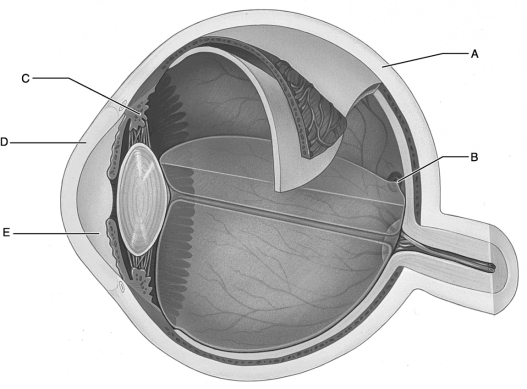A) superior rectus.
B) frontalis on forehead.
C) levator palpebrae superioris.
D) orbicularis oculi.
F) A) and B)
Correct Answer

verified
Correct Answer
verified
Short Answer
The cochlear duct lies between two -filled chambers known as the scala vestibuli and scala tympani.
Correct Answer

verified
Correct Answer
verified
Multiple Choice
The first ʺway stationʺ (relay nucleus) in the visual pathway from the eye, after there has been partial crossover of the fibers in the optic chiasma, is the
A) lateral geniculate nucleus.
B) primary visual cortex.
C) temporal lobe.
D) superior colliculi.
F) A) and B)
Correct Answer

verified
Correct Answer
verified
Multiple Choice
Region of the forebrain overlying the cribriform plate of the ethmoid.
A) temporal lobe
B) olfactory epithelium
C) insula
D) olfactory bulb
E) thalamus
G) A) and D)
Correct Answer

verified
Correct Answer
verified
Short Answer
The three are bony structures involved in the sense of rotational equilibrium.
Correct Answer

verified
Correct Answer
verified
Multiple Choice
Another name for the ciliary zonule is
A) cochlear duct.
B) the bitter taste zone on the tongue.
C) olfactory glomerulus.
D) the suspensory ligament of the lens.
F) C) and D)
Correct Answer

verified
Correct Answer
verified
True/False
Gustatory epithelial cells can be replaced if they are burned or scraped off during eating.
B) False
Correct Answer

verified
Correct Answer
verified
Multiple Choice
 Figure 16.2
Use the diagram above to answer the following questions.
-Identify the letter that indicates the ciliary body.
Figure 16.2
Use the diagram above to answer the following questions.
-Identify the letter that indicates the ciliary body.
A) A
B) B
C) C
D) D
E) E
G) A) and B)
Correct Answer

verified
Correct Answer
verified
Multiple Choice
Gel-like structure embedded with the tips of cochlear hair cells.
A) basilar membrane
B) scala vestibule
C) tympanic membrane
D) tectorial membrane
E) scala tympani
G) B) and D)
Correct Answer

verified
Correct Answer
verified
Essay
Identify the routes by which middle ear infections can easily spread beyond the petrous region of the temporal bone.
Correct Answer

verified
Infections can spread to the brain throu...View Answer
Show Answer
Correct Answer
verified
View Answer
Multiple Choice
The nerve carrying taste information from the anterior two-thirds of the tongue is the
A) hypoglossal.
B) olfactory.
C) glossopharyngeal.
D) facial.
F) A) and B)
Correct Answer

verified
Correct Answer
verified
Multiple Choice
The cristae in the inner ear contain the receptors for
A) all aspects of hearing.
B) all aspects of equilibrium.
C) rotational equilibrium.
D) static equilibrium.
F) A) and D)
Correct Answer

verified
Correct Answer
verified
Multiple Choice
Scientists who are trying to find a way to make neurons divide to heal nerve injuries often study the bodyʹs few mitotic neurons. These neurons are the
A) photoreceptors.
B) basal cells in the taste buds.
C) auditory hair cells.
D) olfactory stem cells.
F) B) and C)
Correct Answer

verified
Correct Answer
verified
True/False
The scala vestibuli is adjacent to the round window, whereas the scala tympani is adjacent to the oval window.
B) False
Correct Answer

verified
Correct Answer
verified
Short Answer
The links the middle ear to the pharynx and is important in equalizing air pressure on both sides of the eardrum.
Correct Answer

verified
pharyngoty...View Answer
Show Answer
Correct Answer
verified
View Answer
Multiple Choice
Which of the following would not be associated with strabismus?
A) paralysis of the extrinsic muscles of the eye
B) damage to the optic nerve
C) damage to the oculomotor nerve
D) lesions of the midbrain
F) B) and C)
Correct Answer

verified
Correct Answer
verified
Multiple Choice
The ora serrata is a
A) part of the retina.
B) part of the choroid layer.
C) part of the modiolus.
D) type of papilla that houses taste buds.
F) B) and D)
Correct Answer

verified
Correct Answer
verified
Multiple Choice
Which of the following is not part of the flow of taste sensation along the gustatory pathway to the cerebral cortex?
A) solitary nucleus of the medulla oblongata
B) thalamic nuclei
C) hypothalamic appetite centers
D) vagus nerve
F) A) and C)
Correct Answer

verified
Correct Answer
verified
Multiple Choice
Nerve axons from the lateral portion of each retina
A) cross over to the opposite side of the retina.
B) pass posteriorly without crossing over at the chiasma.
C) carry information from the lateral half of the visual field.
D) branch at the chiasma, some branches crossing and some not crossing.
F) A) and B)
Correct Answer

verified
Correct Answer
verified
Multiple Choice
Nearsightedness is more properly called
A) myopia.
B) hyperopia.
C) emmetropia.
D) presbyopia.
F) A) and C)
Correct Answer

verified
Correct Answer
verified
Showing 41 - 60 of 117
Related Exams